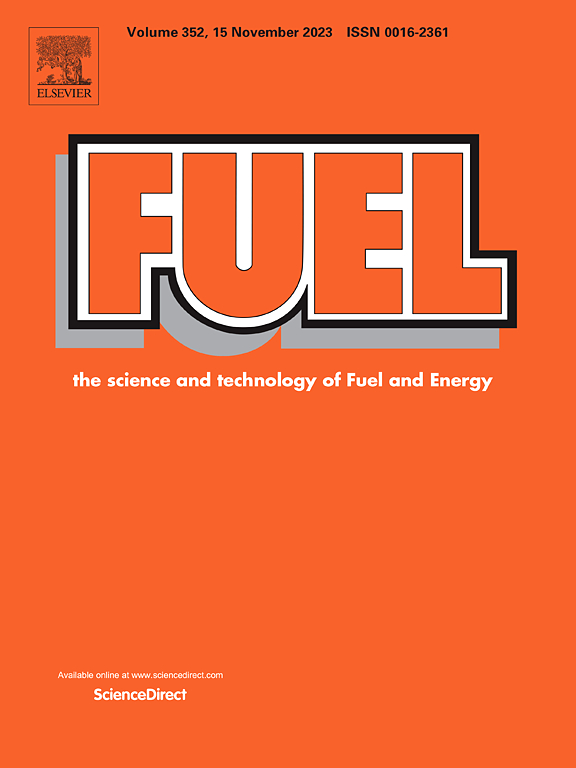Low-temperature CO2 methanation over SiO2 supported Ni catalysts derived from sol-gel precursors: Effect of pretreatment process
IF 7.5
1区 工程技术
Q2 ENERGY & FUELS
引用次数: 0
Abstract
CO2 methanation is a promising approach for simultaneously valorizing CO2 while displacing fossil-derived methane. Although Ni is a well-known earth-abundant methanation catalyst, achieving high activity at low reaction temperatures requires a combination of well-dispersed Ni, proper basicity, and abundant surface oxygen vacancies that is often difficult to achieve over an inert support such as SiO2. Here, we demonstrate the synthesis of active, selective, and stable SiO2-supported Ni (Ni/SiO2) catalysts for low-temperature methanation via the direct H2 reduction of dried sol–gel precursors. At the optimal H2 reduction temperature of 400 °C, above 40 % CO2 conversion and essentially 100 % methane selectivity could be achieved at a reaction temperature of 200 °C (P = 1 bar and GHSV = 8,000 mL⋅gcat.−1⋅h−1). A comprehensive suite of characterizations revealed well-dispersed Ni together with moderate basicity engendered by Ni-O-Si sites. Notably, these Ni-O-Si sites are lost upon air calcination or partially destroyed under higher-temperature H2 pretreatment, highlighting the important effect of pretreatment conditions on catalyst performance. Further, in-situ DRIFTS analysis linked the superior performance of the best catalyst to a high concentration of surface carbonyl intermediates. Overall, these findings not only provide valuable insights into sol–gel syntheses and low-temperature CO2 methanation, but also reveal a simple, scalable, and cost-effective route towards low-temperature methanation catalysts with prospective industrial applications.

溶胶-凝胶前驱体制备的二氧化硅支撑镍催化剂的低温二氧化碳甲烷化:预处理工艺的影响
二氧化碳甲烷化是一种很有前途的方法,可以在取代化石来源的甲烷的同时使二氧化碳增值。虽然Ni是一种众所周知的甲烷化催化剂,但在低反应温度下获得高活性需要分散良好的Ni、适当的碱度和丰富的表面氧空位的组合,而这通常很难在惰性载体(如SiO2)上实现。在这里,我们展示了通过干燥的溶胶-凝胶前驱体直接H2还原,合成了活性,选择性和稳定的SiO2负载Ni (Ni/SiO2)低温甲烷化催化剂。在最佳H2还原温度为400℃时,反应温度为200℃(P = 1 bar, GHSV = 8,000 mL⋅gcat.−1⋅h−1),CO2转化率可达40%以上,甲烷选择性基本为100%。一套全面的表征揭示了分散良好的Ni以及由Ni- o - si位点产生的中等碱性。值得注意的是,这些Ni-O-Si位点在空气煅烧时丢失或在高温H2预处理下部分破坏,突出了预处理条件对催化剂性能的重要影响。此外,原位漂移分析将最佳催化剂的优越性能与高浓度的表面羰基中间体联系起来。总的来说,这些发现不仅为溶胶-凝胶合成和低温二氧化碳甲烷化提供了有价值的见解,而且还揭示了一条简单、可扩展、具有成本效益的低温甲烷化催化剂路线,具有潜在的工业应用前景。
本文章由计算机程序翻译,如有差异,请以英文原文为准。
求助全文
约1分钟内获得全文
求助全文
来源期刊

Fuel
工程技术-工程:化工
CiteScore
12.80
自引率
20.30%
发文量
3506
审稿时长
64 days
期刊介绍:
The exploration of energy sources remains a critical matter of study. For the past nine decades, fuel has consistently held the forefront in primary research efforts within the field of energy science. This area of investigation encompasses a wide range of subjects, with a particular emphasis on emerging concerns like environmental factors and pollution.
 求助内容:
求助内容: 应助结果提醒方式:
应助结果提醒方式:


